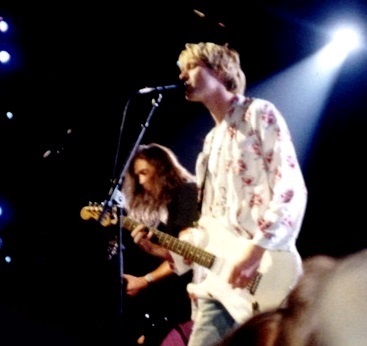Boston remembers Kurt Cobain
https://en.wikipedia.org/wiki/Kurt_Cobain
The following article speaks to the Green Street Station’s role in modern music history. Written by Michael Marotta, it appeared in the April 3, 2009 edition of the Boston Herald and is used with permission. © Copyright by the Boston Herald and Herald Media.
On Sept. 24, 1991, Nirvana’s “Nevermind” was unleashed. It would go on to dethrone Michael Jackson from the top of the Billboard charts, sell more than 10 million copies and change the face of music.
The same day “Nevermind” hit store shelves, Nirvana was in Boston, getting ready for the second of two shows at Axis on Lansdowne Street. Two days earlier, as Kurt Cobain was eating dinner at Division 16 on Boylston Street with WFNX-FM (101.7) program director Kurt St. Thomas, he asked, “So you think anybody’s going to show up to this?”
About 1,000 fans lined Lansdowne Street to get into that first Axis show, a WFNX birthday bash that also featured the then-unknown Smashing Pumpkins and local band Bullet LaVolta.
As the 15th anniversary of Cobain’s suicide arrives this Sunday, Nirvana’s prefame local club shows have become the stuff of legend. Three venues loom large in Nirvana’s local legacy: Green Street Station in Jamaica Plain, ManRay in Cambridge and Axis on Lansdowne Street. Sadly, none remain in business today.
The band’s first Hub gig was at Green Street Station on July 15, 1989, a show notable in its own right: Cobain, who broke his guitar the night before, performed the entire nine-song set without one.
On April 18, 1990, Nirvana played ManRay, performing to some 75 folks piqued by the band’s “Bleach” debut. Local punk band the Bags opened. Despite its place in local lore, recollections of the event are hazy.
“I was at that show, but I don’t have too many memories besides the fact that it was loud,” said the club’s longtime DJ, Chris Ewen, who did recall Cobain briefly singing an impromptu rendition of Madonna’s “Like a Prayer.”
Ashmont Media’s Joyce Linehan, who booked the show, is also fuzzy on details.
“I really don’t remember it being that remarkable,” Linehan said. “There weren’t a lot of people there.”
But St. Thomas was.
“The show blew me away,” he said. “I remember they thought it was really weird that I worked at a commercial radio station.”
St. Thomas would go on to play Nirvana on the radio, but mostly in the wee hours. Eight months before “Nevermind” came out in 1991, he pleaded with Geffen Records to put Nirvana on the bill for the ’FNX eighth anniversary show.
“I just wanted to book my favorite band,” St. Thomas said. “I had no idea what was going to happen. They agreed to play the gig, and it was the only free gig they ever played for a radio station.”
A month before the 1991 Axis show, St. Thomas was the first DJ to play “Smells Like Teen Spirit” on the radio.
“There was nothing on ’FNX like it,” he recalled. “No other song immediately ignited a response like that. But nobody knew the name. People would call in and say, ‘What was that mosquito song?’ ”
By the time the Axis show rolled around that September, fans were ready to embrace a new sound called grunge.
Nirvana then agreed to play a second gig after being, as St. Thomas puts it, “bummed” by the 21-plus age policy at the show. So they scheduled a second Axis performance the next night with an 18-and-older admission policy in effect.
By the time Nirvana hit the stage, “Nevermind” was in stores. Cobain would never again have to worry about people showing up to a show.
By Michael Marotta

